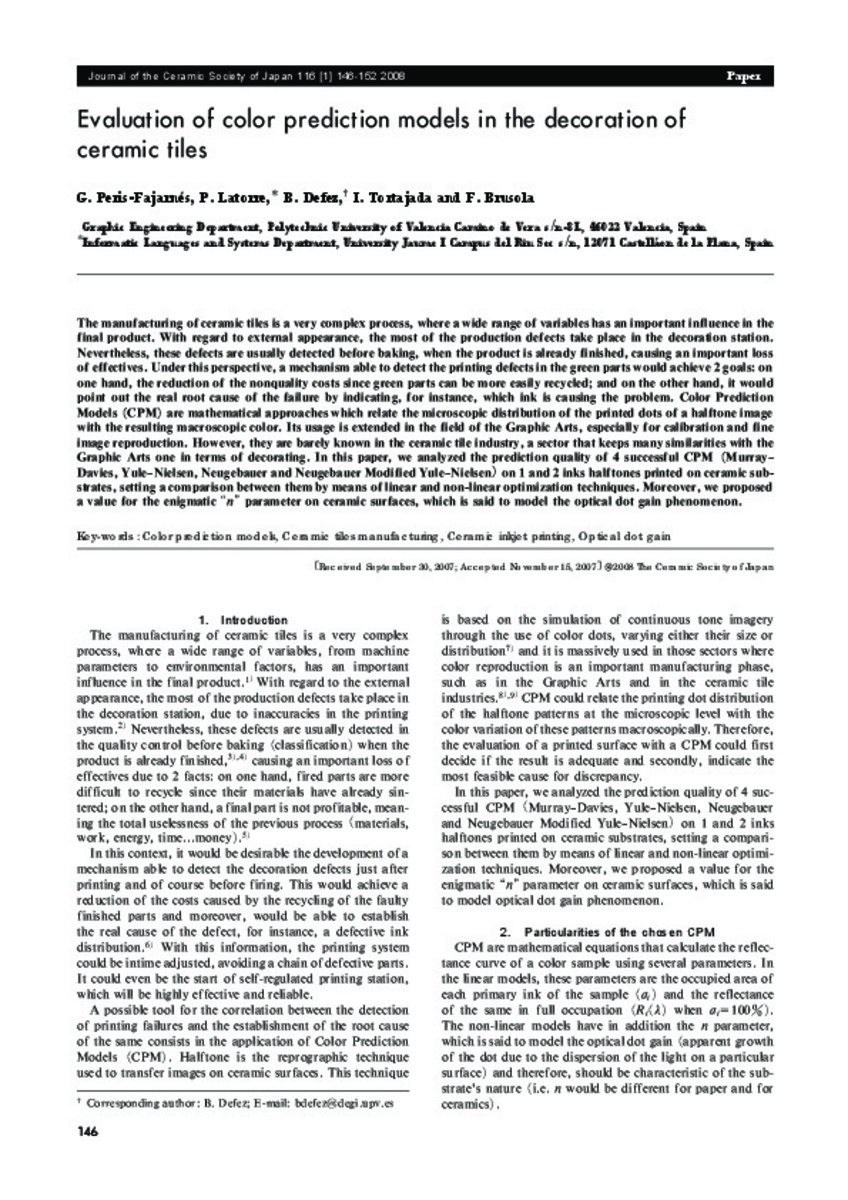Mostrar el registro sencillo del ítem
Evaluation of color prediction models in the decoration of ceramic tiles
| dc.contributor.author | Latorre Carmona, Pedro | |
| dc.contributor.author | Peris Fajarnés, Guillermo | |
| dc.contributor.author | Defez, B. | |
| dc.contributor.author | Tortajada, I. | |
| dc.contributor.author | Brusola Simon, Fernando | |
| dc.date.accessioned | 2010-09-13T18:03:49Z | |
| dc.date.available | 2010-09-13T18:03:49Z | |
| dc.date.issued | 2008 | |
| dc.identifier.issn | 09145400 | |
| dc.identifier.uri | http://hdl.handle.net/10234/18173 | |
| dc.description | The manufacturing of ceramic tiles is a very complex process, where a wide range of variables has an important influence in the final product. With regard to external appearance, the most of the production defects take place in the decoration station. Nevertheless, these defects are usually detected before baking, when the product is already finished, causing an important loss of effectives. Under this perspective, a mechanism able to detect the printing defects in the green parts would archieve 2 goals: on one hand, the reductions of the nonquality consts since green parts can be more easily recycled; and on the other hand, it would point out the real root cause of the failure by indicating, for instance, which ink is causing the problem. Color Prediction Models (CPM) are mathematical approaches which relate the microscopic distribution of the printed dots of a halftone image withe the resulting macroscopic color. It usage is extended in the field of Graphic Arts, especially for calibration and fine image reproduction. However, they are barely known in the ceramic tile industry, a sector that keeps many similarities with the Graphic Arts one in terms of decorating. In this paper, we analyzed the prediction quality of 4 succesful CPM (Murray-Davies, Yule-Nielsen, Neugebauer an Neugebauer Modified Yule-Nielsen) on 1 and 2 inks halftones printed on ceramic substrates, setting a comparison between them by means of linear and non-linear optimization techniques. Moreover, we proposed a value for the enigmatic "n" parameter on ceramic surfaces, which is said to model the optical dot gain phenomenon. | |
| dc.format.extent | P. 146-152 | |
| dc.language.iso | eng | |
| dc.publisher | The Ceramic Society of Japan | |
| dc.relation.isPartOfSeries | Journal of the Ceramic Society of Japan;116 (1) | |
| dc.rights.uri | http://rightsstatements.org/vocab/CNE/1.0/ | * |
| dc.subject | Color prediction models | |
| dc.subject | Ceramic tiles manufacturing | |
| dc.subject | Ceramic inkjet printing | |
| dc.subject | Optical dot gain | |
| dc.subject.other | Color en la indústria ceràmica | |
| dc.title | Evaluation of color prediction models in the decoration of ceramic tiles | |
| dc.type | info:eu-repo/semantics/article | |
| dc.rights.accessRights | info:eu-repo/semantics/openAccess | |
| dc.type.version | info:eu-repo/semantics/publishedVersion |
Ficheros en el ítem
Este ítem aparece en la(s) siguiente(s) colección(ones)
-
LSI_Articles [362]
Articles de publicacions periòdiques escrits per professors del Departament de Llenguatges i Sistemes Informàtics







